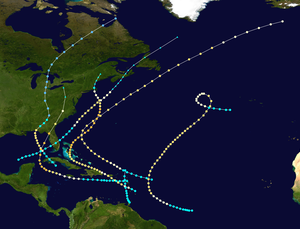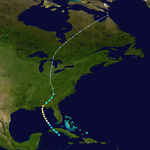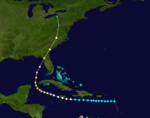1896 Atlantic hurricane season
| 1896 Atlantic hurricane season | |
|---|---|
 Season summary map | |
| Seasonal boundaries | |
| First system formed | July 4, 1896 |
| Last system dissipated | November 29, 1896 |
| Strongest storm | |
| Name | Two |
| • Maximum winds | 115 mph (185 km/h) (1-minute sustained) |
| • Lowest pressure | 956 mbar (hPa; 28.23 inHg) |
| Seasonal statistics | |
| Total storms | 7 |
| Hurricanes | 6 |
| Major hurricanes (Cat. 3+) | 2 |
| Total fatalities | 286 |
| Total damage | $10 million (1896 USD) |
| Related article | |
The 1896 Atlantic hurricane season was fairly inactive but produced one of the costliest hurricanes ever to strike the United States until that point, along with several other destructive
The first hurricane made landfall in the
Timeline

Systems
Hurricane One
| Category 2 hurricane (SSHWS) | |
| Duration | July 4 – July 9 |
|---|---|
| Peak intensity | 100 mph (155 km/h) (1-min); |
The first documented tropical cyclone of the 1896 season has unclear origins. Although its official track in the
Widespread damage was reported in Pensacola and along the coast, with watercraft suffering the greatest losses. In the city's harbor, the storm sank nine fishing boats, damaged two
Hurricane Two
| Category 3 hurricane (SSHWS) | |
| Duration | August 30 – September 10 |
|---|---|
| Peak intensity | 115 mph (185 km/h) (1-min); 956 mbar (hPa) |
Hurricane San Ramón of 1896
On August 30, a tropical storm materialized east of the Lesser Antilles, on a northwestward course.[9] The next night, it made landfall on the southern coast of Puerto Rico as a Category 2 hurricane, accompanied by severe rain and wind.[1][10] The storm passed just north of Hispaniola and Cuba over the next several days,[1] delivering tropical storm-force winds to the islands.[10] On the evening of September 6, while near the Bahamas, a steamship crossed the center of the hurricane and recorded a barometric pressure of 28.24 inHg (956 mbar).[11] This corresponds to maximum sustained winds of 115 mph (185 km/h), or a Category 3 major hurricane, which represents storm's peak intensity.[10] The ship suffered extensive damage and lost one crew member when he fell overboard.[1] Tracking generally northward, the storm weakened to minimal hurricane intensity before making landfall over eastern Massachusetts on September 10, with 80 mph (130 km/h) maximum sustained winds extending to a radius of 35 mi (55 km) from the center.[2][10] Sustained hurricane-force winds were observed in both Rhode Island and Massachusetts as the storm moved ashore.[12] The system transitioned into an extratropical cyclone shortly thereafter.[2]
Several rivers in Puerto Rico overflowed, leading to extensive flooding. Five homes were destroyed along the coast of
Hurricane Three
| Category 2 hurricane (SSHWS) | |
| Duration | September 18 – September 28 |
|---|---|
| Peak intensity | 100 mph (155 km/h) (1-min); |
An unusually large storm formed east of the
Hurricane Four
| Category 3 hurricane (SSHWS) | |
| Duration | September 22 – September 30 |
|---|---|
| Peak intensity | 125 mph (205 km/h) (1-min); 960 mbar (hPa) |
The Cedar Keys Hurricane of 1896
The most destructive tropical cyclone of the season, and one of the costliest hurricanes ever to strike the United States at the time,
The Cedar Keys were struck by a devastating 10.5 ft (3.2 m) storm surge that undermined buildings, washed out the connecting railroad to the mainland, and fully submerged the smaller, outlying islands where 31 people were killed.[21][22] Strong winds destroyed many of the red cedar trees that played an important role in the economy of the region,[23] and several cedar mills were severely damaged or destroyed.[24] In interior Florida, the hurricane devastated many communities, leaving thousands of people homeless.[25][26] Few homes or businesses were left standing in the hardest-hit areas.[27] In northern Florida and southern Georgia, the hurricane razed millions of acres of pine forests, which crippled the local turpentine industry.[28] In Savannah, Georgia, a 45-minute onslaught of fierce winds unroofed thousands of structures and left parks in a state of disarray.[29][30] Damage to shipping and shoreline settlements in the Sea Islands was extensive.[31]
As the hurricane continued northward, cities and agricultural districts alike suffered extensive damage in
Hurricane Five
| Category 2 hurricane (SSHWS) | |
| Duration | October 7 – October 13 |
|---|---|
| Peak intensity | 100 mph (155 km/h) (1-min); |
The East Coast Hurricane of 1896
This cyclone was first noted in the southern
The storm had generally minor effects in Florida, mostly limited to coastal flooding in northeastern portions of the state.
Hurricane Six
| Category 2 hurricane (SSHWS) | |
| Duration | October 26 – November 9 |
|---|---|
| Peak intensity | 100 mph (155 km/h) (1-min); |
Little is known about the sixth storm of the season, which was first observed near 9°N 44°W / 9°N 44°W on October 17, and intensified into a moderate hurricane as it roamed the open Atlantic for two weeks. It was last noted near 36°N 35°W / 36°N 35°W on November 9.[2] On October 28, a ship was damaged by a severe squall or possible tornado, accompanied by frequent thunder and lightning, about 800 mi (1,300 km) to the northwest of the storm's estimated track. This incident may have been related to the hurricane if it were exceptionally large, and represents the only extant observation of the storm that modern reanalysis efforts were able to uncover.[10]
Tropical Storm Seven
| Tropical storm (SSHWS) | |
| Duration | November 27 – November 29 |
|---|---|
| Peak intensity | 60 mph (95 km/h) (1-min); |
The final documented system of 1896 formed over the far southern
On Montserrat, one plantation recorded at least 21.15 in (537 mm) of rain in 21 hours, though the rain gauge overflowed between each of the three observations, preventing an accurate total from being obtained. It was speculated that several feet of rain may have locally fallen on certain hillsides, as evidenced by landslides that swept away trees, boulders, and large volumes of earth.
See also
References
Specific
- ^ a b c d e f g h i j k l m n o p q r Partagás, José Fernández (1995). "A Reconstruction of Historical Tropical Cyclone Frequency in the Atlantic from Documentary and other Historical Sources: Year 1896" (PDF). National Oceanic and Atmospheric Administration. Retrieved February 14, 2017.
- ^ a b c d e f g h i j k l m Hurricane Research Division (June 16, 2016). "Atlantic hurricane best track (HURDAT version 2)". National Oceanic and Atmospheric Administration. Retrieved February 14, 2017.
- . Retrieved February 16, 2017.
- ^ . Retrieved February 16, 2017.
- ^ United States Army Corps of Engineers (1945). Storm total rainfall in the United States. War Department. p. SA 3–4.
- ^ a b Barnes, p. 77
- ^ Orlando Férez (1970). "Notes on the Tropical Cyclones of Puerto Rico" (PDF). San Juan, Puerto Rico National Weather Service. Retrieved February 26, 2017.
- ^ a b c d e f Hurricane Research Division (May 2015). "Documentation of Atlantic Tropical Cyclones Changes in HURDAT". National Oceanic and Atmospheric Administration. Retrieved February 14, 2017.
- . Retrieved February 16, 2017.
- ^ Atlantic Oceanographic and Meteorological Laboratory (July 2016). "Continental United States Hurricane Impacts/Landfalls 1851-2015". National Oceanic and Atmospheric Administration. Retrieved February 26, 2017.
- ^ . Retrieved February 16, 2017.
- ^ "Historical Report Database". Harvard Forest. Harvard University. 2001. Retrieved February 16, 2017.
- ^ Snow, pp. 237–238
- ^ Schwartz, p. 101
- ^ Barnes, p. 78
- ^ National Weather Service Tampa Bay Area. "Hurricane of 1896 Strikes with a Fury: Fact Sheet" (PDF). National Oceanic and Atmospheric Administration. Retrieved January 29, 2017.
- ^ Oickle, pp. 59–61
- ^ Oickle, p. 97
- ^ Oickle, p. 53
- ^ Oickle, p. 65
- ^ Oickle, p. 66
- . Retrieved January 29, 2017.
- ^
- ^ a b Roth, David M. "Virginia Hurricane History: Late Nineteenth Century". Weather Prediction Center. Retrieved February 2, 2017.
- ^ Schwartz, p. 103
- . Retrieved February 3, 2017.
- ^ a b Schwartz, p. 105
- ^ "National Park Service Discovers Bullets in Downed Witness Tree on Culp's Hill". Gettysburg Daily. August 10, 2011. Retrieved February 11, 2017.
- ^ View expanded list of sources
- * 115 in Florida:
- 31 in the Cedar Keys; 21 in Nassau County; 5 in Bradford County: Oickle, pp. 74, 76–77, 109; "Death list growing". The Semi-Weekly Times-Democrat. October 2, 1896. p. 1. Retrieved February 1, 2017 – via
- 8 on a wrecked sailboat north of Tampa: "Eight more victims found on the Florida coast". The Times-Democrat. October 17, 1896. Retrieved February 4, 2017 – via
- 7 in Baker County; 8 in Suwannee County; 9 in Columbia County; 12 in Alachua County; 13 in interior Levy County: "Worse than dead by far". The Semi-Weekly Times-Democrat. October 6, 1896. p. 9. Retrieved February 2, 2017 – via
- 1 in Grady: "Cyclone killed scores". The Sun. October 2, 1896. p. 1. Retrieved February 2, 2017 – via
- 37 in Georgia:
- At least 17 in and around Savannah; 5 in Brunswick; 1 in Folkston: Fraser, pp. 188–189
- 6 in Camden County: Oickle, p. 77
- 8 in Darien: "Work of the gale at Darien". The Atlanta Constitution. October 2, 1896. p. 1. Retrieved January 31, 2017 – via
- 7 in South Carolina: Oickle, p. 80
- 1 in North Carolina: "Great damage to property caused by Tuesday's storm". The Weekly Star. October 2, 1896. p. 2. Retrieved February 2, 2017 – via
- 13 in Virginia: Schwartz, p. 102; Central Shenandoah Planning District Commission. "CSPDC Flooding Hazard History" (PDF). City of Virginia Beach. p. 4. Retrieved February 2, 2017.
- 1 in Washington, D.C.: Roth, David M. "Virginia Hurricane History: Late Nineteenth Century". Weather Prediction Center. Retrieved February 2, 2017.
- 8 in Maryland: Henry, A. J. (September 1896). "Local Storms" (PDF). . Retrieved January 29, 2017.
- 16 in Pennsylvania:
- 6 in Philson, Pennsylvania: "Many lives lost". The Algona Republican. October 7, 1896. p. 3. Retrieved February 3, 2017 – via
- 6 in Natalie, Pennsylvania: "Ruin in its path". The Chicago Daily Tribune. October 1, 1896. p. 7. Retrieved January 31, 2017 – via
- 2 in Shamokin, Pennsylvania; 2 in Reading: Schwartz, p. 107
- 4 on barge Sumatra in Lake Michigan: "Ruin in its path". The Chicago Daily Tribune. October 1, 1896. p. 7. Retrieved January 31, 2017 – via
- * 115 in Florida:
- ^ View expanded list of sources
- * $3 million in Florida: Barnes, p. 77
- $1 million in Virginia: Berry, James (September 1896). "Climate and Crop Service" (PDF). .
- $1 million in Savannah; $500,000 in turpentine losses in Georgia; $150,000 on St. Simons Island: Fraser, pp. 188–189
- $400,000 in Washington, D.C.: Hazen, H. A. (September 1896). "The Wind-rush of September 29, 1896" (PDF). . Retrieved February 3, 2017.
- $2 million in Pennsylvania; $500,000 in Maryland; $50,000 in New York; $45,000 in the Carolinas: Henry, A. J. (September 1896). "Local Storms" (PDF). . Retrieved January 29, 2017.
- $500,000 in the Sea Islands; $75,000 on the Great Lakes: "Many lives lost". The Algona Republican. October 7, 1896. p. 3. Retrieved February 3, 2017 – via
- $150,000 in Richmond, Virginia: Roth, David M. "Virginia Hurricane History: Late Nineteenth Century". Weather Prediction Center. Retrieved February 2, 2017.
- * $3 million in Florida: Barnes, p. 77
- ^
- ^ . Retrieved February 14, 2017.
- ^
- ^ Schwartz, p. 108
- ^
- ^
Works cited
- Barnes, Jay (2007). Florida's Hurricane History. ISBN 978-0807858097.
- Oickle, Alvin F. (2009). Disaster at Dawn: The Cedar Keys Hurricane of 1896. ISBN 978-1614234852.
- Schwartz, Rick (2007). Hurricanes and the Middle Atlantic States. Blue Diamond Books. ISBN 978-0978628000.
- Snow, Edward Rowe (1943). Great Storms and Famous Shipwrecks of the New England Coast. Yankee Publishing Company.












